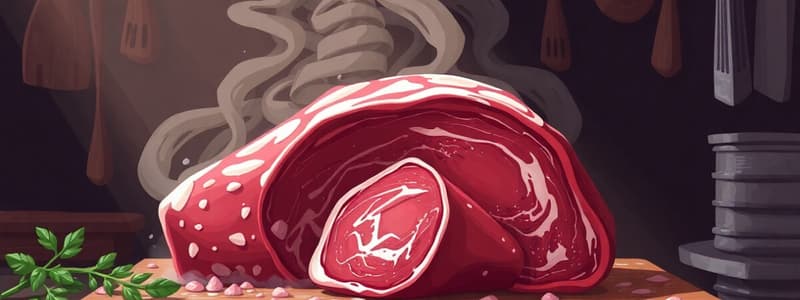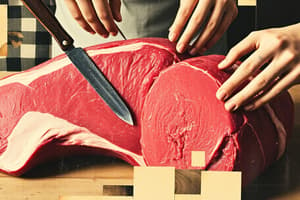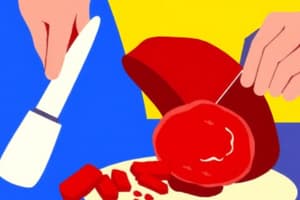Podcast
Questions and Answers
What role does the bone structure play in the fabrication process?
What role does the bone structure play in the fabrication process?
- It determines the cooking time of the meat.
- It is used to season the meat.
- It influences the flavor profile of the cuts.
- It helps in identifying whether the animal is young or old. (correct)
What is a characteristic of the porterhouse steak?
What is a characteristic of the porterhouse steak?
- It is the least expensive cut.
- It has a T-shaped bone and includes two tender muscles. (correct)
- It contains a smaller tenderloin than the T-bone steak.
- It is primarily derived from the forequarter.
Which of the following are the wholesale cuts from the hindquarter of beef?
Which of the following are the wholesale cuts from the hindquarter of beef?
- Ribs, plate, shoulder
- Brisket, foreshank, chuck
- Tenderloin, sirloin, short plate
- Flank, navel, round, loin (correct)
Which category does trimmed ham fall under?
Which category does trimmed ham fall under?
What is a common characteristic of the heel of round cut?
What is a common characteristic of the heel of round cut?
How long should a carcass be chilled to optimize fabrication?
How long should a carcass be chilled to optimize fabrication?
Which is a characteristic feature of T-bone steak?
Which is a characteristic feature of T-bone steak?
Which of the following is considered a miscellaneous cut of pork?
Which of the following is considered a miscellaneous cut of pork?
Which of the following cuts is found in the front quarter of beef?
Which of the following cuts is found in the front quarter of beef?
What happens to the tenderness of cuts that contain thoracic bones?
What happens to the tenderness of cuts that contain thoracic bones?
Study Notes
Fabrication Overview
- Fabrication refers to cutting carcasses into wholesale and retail cuts.
Objectives
- Understand principles behind fabrication.
- Identify and list wholesale cuts.
- Recognize retail cuts derived from wholesale cuts.
Role of Bone Structure
- Acts as a guide for cutting carcasses.
- Indicates cut tenderness:
- Cuts with thoracic/lumbar bones are tender.
- Cuts from tibia, radius, and ulna are tougher.
- Cuts with scapula, humerus, and femur have medium tenderness.
- Assists in cut identification and age determination of the animal.
General Fabrication Procedures
- Chill carcasses at 2°C:
- 48 hours for carabeef and beef.
- 24 hours for pork.
- Cut pork carcass at 16°C.
Wholesale Cuts of Beef/Carabeef
- Front Quarter includes:
- Ribs, plate/short plate, brisket, foreshank, chuck.
- Hindquarter includes:
- Flank/navel, round, loin.
Specific Cuts
- Porterhouse Steak:
- Contains T-shaped bone.
- Features tenderloin and sirloin muscles.
- Most expensive cut; yields six slices per animal.
- T-Bone Steak:
- Similar to porterhouse but with smaller tenderloin.
- Club Steak:
- Last two one-inch slices of loin, lacks tenderloin muscle.
Retail Cuts from Hindquarter
- Round features various cuts:
- Rump roast, sirloin tip (boneless and easily formed), medium tender round steak, tough heel of round, soup bones.
Pork Cuts Classification
- Divided into three categories:
- Lean Cuts: Ham, loin, shoulder.
- Primal Cuts: Ham, loin, belly, shoulder.
- Miscellaneous Cuts: Pig’s feet, tail, fat/lean trimmings, neckbones, spare ribs.
Wholesale and Retail Cuts of Pork
- Shoulder/Batuk:
- Includes shoulder butt/Boston butt (bladebone), picnic (contains shank), neckbones, clear plate (lard), and jowl.
- Ham/Pige:
- Features trimmed ham, ham shank and butt, and center slice.
- Loin/Lomo:
- Cuts include pork chop (kostillas), center loin, loin end, and blade end.
- Belly/Side/Liempo: Further details not specified.
Studying That Suits You
Use AI to generate personalized quizzes and flashcards to suit your learning preferences.
Related Documents
Description
This quiz covers the principles and procedures involved in the fabrication of meat cuts, including the identification of wholesale and retail cuts. Participants will gain an understanding of bone structures and their role in determining cut tenderness. Additionally, it highlights specific cuts of beef and carabeef.




